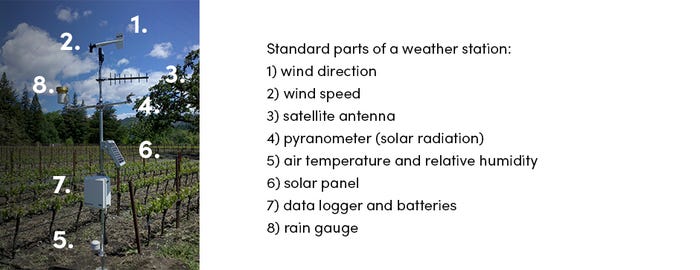October 10, 2017

Weather is an inevitable factor in every crop production. Knowing real-time weather conditions like temperature, precipitation, and humidity is the best way to protect crops from the harmful impact of adverse weather events as well as pests. In fact, accurate monitoring of weather data can greatly affect crop yield and overall farm productivity and profitability.
Weather monitoring is an important activity in farm management, especially prior to sowing, harvesting or some other activity crucial for successful crop establishment and yield.
Since the beginning of agriculture, farmers have monitored weather conditions in order to prevent seed and later, yield losses. First weather monitoring was very primitive, based on weather patterns in a particular location. Today, farmers have plenty of sources to obtain accurate weather forecasts, such as TV, Internet, and various mobile applications. Nevertheless, farmers increasingly set their own weather stations in the field.
What Makes a Modern Weather Station?
Modern agriculture offers diverse systems for precise monitoring of weather conditions. Farmers are therefore able to use the most sophisticated weather monitoring equipment. Such modern systems can measure both soil and environmental parameters related to evapotranspiration, plant growth, and development as well as irrigation schedule and insect pest and disease modeling.
A weather station consists of multiple sensors which provide data about air temperature, wind speed and direction (at 6 m), rainfall, snow depth, relative humidity, and solar radiation. It can also be integrated with other sensors to provide information about soil temperature, moisture, and available water. Though sensors can be networked in hardwired or wireless systems.
There are various weather station types but they all have additional common parts. They are as follows:
•Anemometer; measures wind speed
•Wind vane; measures wind direction; it can be placed on standard heights of 6 and 10 m
•Satellite and GPS antenna
•Pyranometer; measures solar radiation or photosynthetically active radiation
•Temperature sensor; electronic sensor or manual thermometer usually hidden from the sun in a wooden or plastic Stevenson screen
•Electronic capacitive sensor; measures relative humidity; sensor is placed along with temperature sensor
•Solar panel; power and automate the weather station
•Rain gauge; measures rainfall amount; it accumulates the rain in a glass or a plastic measuring cylinder
•Batteries
•Data logger –small module that connects the weather station to a computer or network and archives or shares real-time data (readings refreshed every few seconds).

Data logging is the measuring and recording of physical or electrical parameters over a period of time. Devices that measure and log data, called data loggers, come in different shapes and sizes. Data loggers are available in various shapes, sizes, and work range. The range covers both simple and low-cost single and sampling channel loggers, as well as more powerful multi-channel and integrating devices capable of handling hundreds of inputs at once.

Where to Place a Weather Station?
Despite the possibility of measuring various weather parameters, the placement of a weather station is also an important factor. A weather station needs to be placed on a level ground in a grassed area, away from buildings. Hence, in farm production of many different crop types, a weather station should not be placed near a particular crop so that it could measure weather conditions over the entire field block as far as possible.
Not only this practice avoids sensor damage during crop management activities but also it ensures real-time data of different crop types and canopies over the large area. Weather station placed too close to one crop will not provide accurate weather data for other crops on the measured area.

Automatic Weather Station
Besides weather stations for amateur use for farmers, there are also automatic stations for professional measurement of weather conditions. They are often used in meteorology or in areas where the commercial power or communication networks are limited or non-existent.
These stations provide all weather data on which experts can create an individual or collective decision about crops, disease models, potential evapotranspiration, and irrigation management models. The automatic weather station is helpful with the forecast and agrometeorological services in a way that it implements smart farming methods and optimizes farm production.
Farm technology is constantly improving by becoming more sophisticated and digital. Based on data-driven decisions, farmers are able to enhance their crop production and make farming more efficient and easier than ever. Modern equipment for accurate weather monitoring is only one step away from achieving that goal and providing sustainable farming.
You May Also Like




